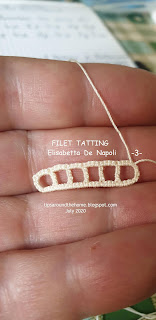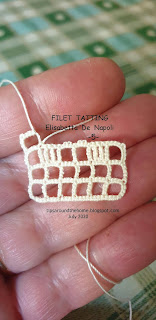Day 2 of my Distraction continues.....7
As I said yesterday, I wound 2 shuttles, ctm, with Anchor size 40, and started Robin's Challenge Snowflake. Rounds 1 & 2 seen.
Then I deliberately left off and picked up the size 80 edging. 13 repeats done so far.
Both patterns can be found here - http://tattingbythebay.blogspot.com/p/free-patterns.html
Ruthie May is tatting along, working the snowflake in 6 stranded embroidery thread and using needle.
After 2 rounds, the snowflake measures 1.5". I like how the padded chains keep their shape. I think it's the first time I worked it in size 40. So much neater than size 20. (https://tipsaroundthehome.blogspot.com/2015/11/pds-padded-double-stitch.html)
I've used self-closing mock Josephine Rings in 2 of my patterns - I had called it SCM(J)R, not having come across it before. Love them!
https://tipsaroundthehome.blogspot.com/2016/06/under-pinning.html and
https://tipsaroundthehome.blogspot.com/2019/11/frost-flower-pictopattern.html
Followed the pattern exactly, except for this lock join in the end. I substituted it with Reverse Join because I want the red shuttle back in action in next round. (https://tipsaroundthehome.blogspot.com/2020/07/lock-join-plus.html)
Let's see what tomorrow brings. I'll have to get back to my usual (new) life routine, so.... What I do know is that I am having fun :-D
As I said yesterday, I wound 2 shuttles, ctm, with Anchor size 40, and started Robin's Challenge Snowflake. Rounds 1 & 2 seen.
Then I deliberately left off and picked up the size 80 edging. 13 repeats done so far.
Both patterns can be found here - http://tattingbythebay.blogspot.com/p/free-patterns.html
Ruthie May is tatting along, working the snowflake in 6 stranded embroidery thread and using needle.
After 2 rounds, the snowflake measures 1.5". I like how the padded chains keep their shape. I think it's the first time I worked it in size 40. So much neater than size 20. (https://tipsaroundthehome.blogspot.com/2015/11/pds-padded-double-stitch.html)
I've used self-closing mock Josephine Rings in 2 of my patterns - I had called it SCM(J)R, not having come across it before. Love them!
https://tipsaroundthehome.blogspot.com/2016/06/under-pinning.html and
https://tipsaroundthehome.blogspot.com/2019/11/frost-flower-pictopattern.html
Followed the pattern exactly, except for this lock join in the end. I substituted it with Reverse Join because I want the red shuttle back in action in next round. (https://tipsaroundthehome.blogspot.com/2020/07/lock-join-plus.html)
Let's see what tomorrow brings. I'll have to get back to my usual (new) life routine, so.... What I do know is that I am having fun :-D



























































